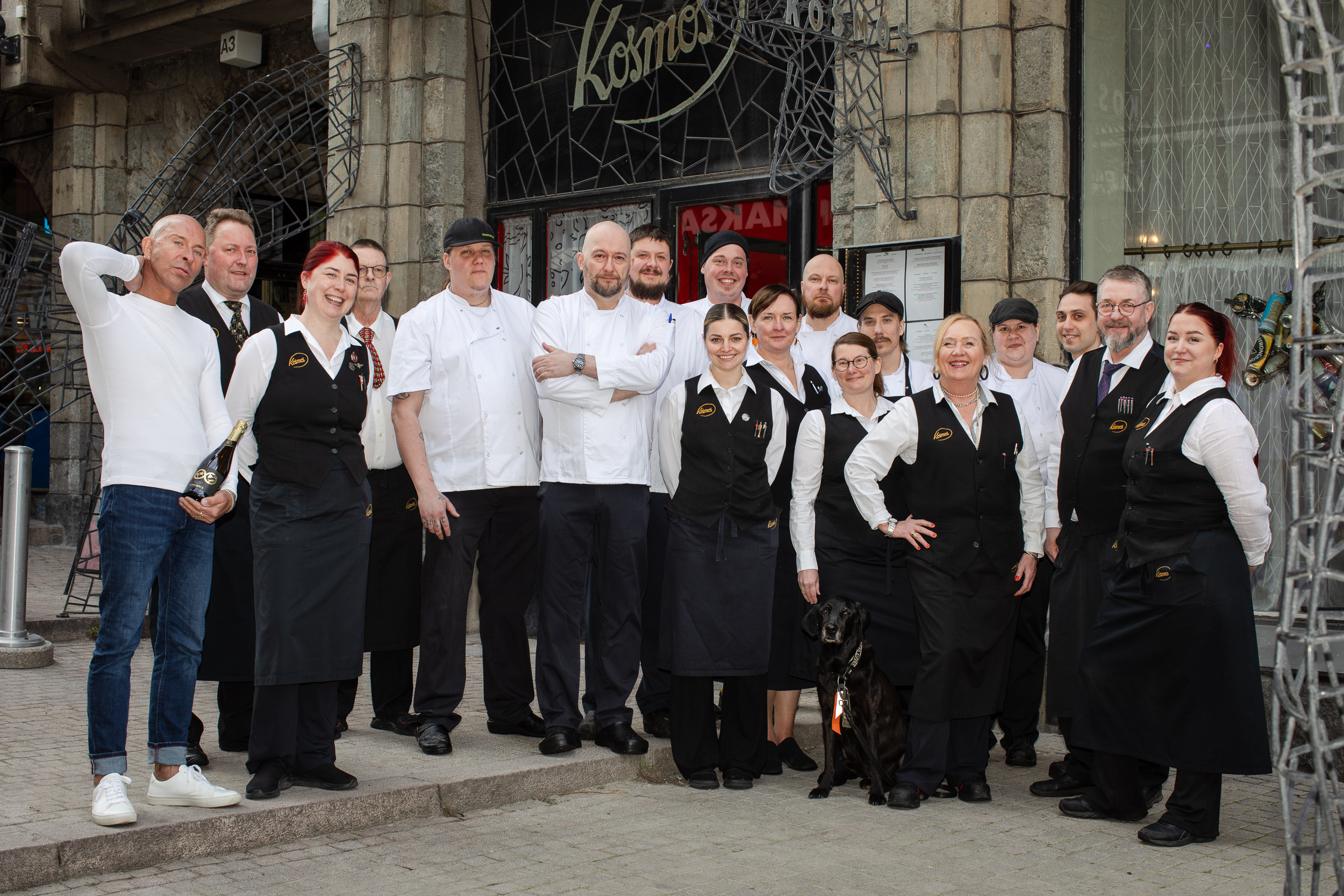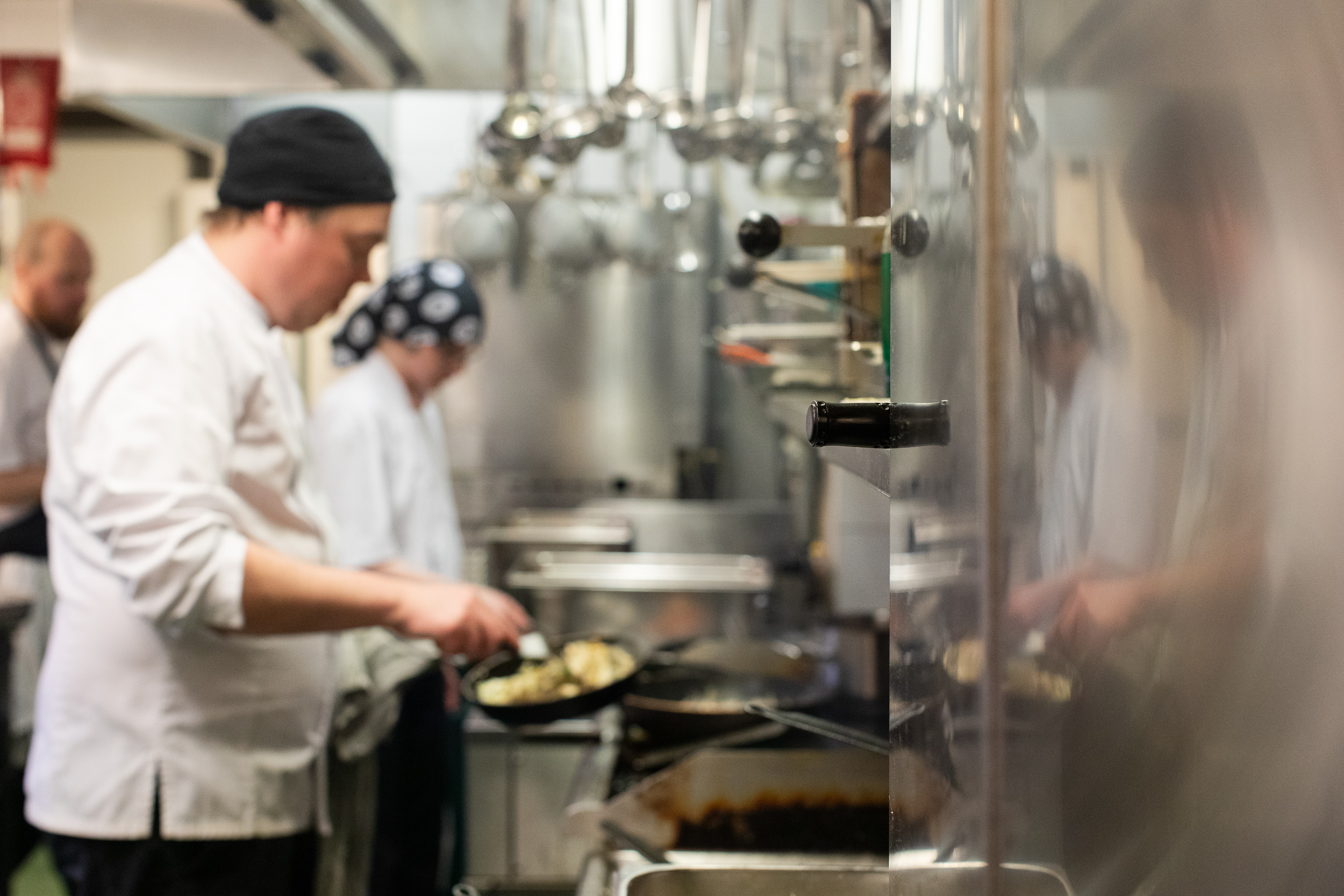The world
of Kosmos
Kosmos has been shining bright on Helsinki’s restaurant scene for 100 years. Many other restaurants have opened and closed their doors whilst Kosmos has endured, flourished and remained in the heart of Helsinki.
The family-owned restaurant was opened on August 6th in 1924. Today, Kosmos is run by the 4th generation of the restaurant’s owner. The décor is easy going and the service is thoughtful. The classic European gastronomy has remained the same from decade to decade. In addition, the long-lasting staff has always been a part of the Kosmos family. The owner’s son has taken after his father as a cloakroom attendant and the experienced chefs and servers, with their incomparable expertise, have created unforgettable experiences for customers for over 30 years.
Regular customers have enjoyed Kosmos’ universe for decades: presidents, artists, businesspeople, students and, last but not least, travellers who seek the experience of an authentic Finnish restaurant culture. All these individuals have found their way to Kosmos and enjoyed its atmosphere and traditional cuisine.
The history of Kosmos is filled with memories of a well-lived life, unforgettable people and great food. The most important things for us has always been our customers and our original, straightforward and broad-minded business idea: to serve “impartially the wealthy and the poor, the civil elite and everyday customers”.
Welcome!
IRINA HEPOLAMPI & KIIRA HEPOLAMPI

THE HISTORY OF KOSMOS
A family owned restaurant, dining hall, canteen, culture spot…
By 1924, when Yrjö Teodor Lindfors established Kosmos ruokasalit (The Kosmos dining rooms) on what was then known as the Vladimirinkatu street, prohibition prevailed in Finland. Nevertheless, there was significant demand for a modern, upscale yet moderately priced restaurant in the fast-growing capital city of Helsinki. The new venue quickly found favour, particularly among university students. Irina Hepolampi recalls that according to her grandfather, “the students lacked an affordable dining place, so he thought he would set up a simple restaurant with no carpets, no curtains, not even tablecloths. Just tiled floors and marble tables. It was easy to keep clean – for students and travellers”.
The easing of the Great Depression ushered in a new era in which Vladimirinkatu was replaced with the more patriotic Kalevankatu, the Swedish name Lindfors was fashionably translated into the Finnish Hepolampi, and 1932 brought the repeal of prohibition. The growing prosperity brought in new customers: lawyers, artists, civil servants, businessmen – even the occasional businesswoman.
Mrs Aino Hepolampi eventually took charge of her husband’s enterprise, thus becoming one of Helsinki’s very few female restaurateurs. Kosmos was marketed as a cosy, highly popular and comfortable place with full serving rights, renowned for its excellent cuisine. On weekday evenings and Sunday afternoons the restaurant featured live music by orchestras and ‘revue singers’.
In the spring of 1934, Kosmos was renovated and introduced the look that the restaurant is known for to this day. Architect and decorative painter Arvo O. Aalto planned the overall look of the dining hall and furniture designer Einari Kyöstilä designed the interior. The new lodges were decorated with wood reliefs of Hellenic themes, sculpted by Eino Räsänen.
Despite the escalating threat of war in the late 1930s, Helsinki experienced a surge in prosperity and optimism surrounding the preparation for the 1940 Olympic Games. Much like Berlin’s transformation four years earlier, the impending Olympics spurred a wave of initiatives aimed at planning, beautifying, and modernizing the city. This period also saw a more favorable attitude towards restaurants and catering, marking a new phase in Helsinki’s urban development. The city’s commerce and consumption began to reflect the prevailing spirit of optimism, signifying a shift in its urban landscape.
During the war, stringent food regulations made it tough for restaurants to thrive. However, in 1944, as the war neared its end, Kosmos was leased to the German army. The officers who spent time there generated crucial revenue, providing a lifeline to the struggling restaurant.
Post-war, long lunches were once more complemented by schnapps, followed by punch and brandy, and then continued with the grogs that were typical of the period.
In a moralistic campaign by the state, alcohol monopoly restricted liquor consumption and its availability in restaurants, and Kosmos was gravely reprimanded for disproportionate sales of strong spirits.
The enduring favourites on the menu – escalope of veal à la Oscar, pork chop Robert and fried salmon with tartar sauce – gradually came to be accompanied by international newcomers such as paella, chop suey and cannelloni.
In the 1950s, magazine editors and visual artists had joined the clientele, and in the 1960s, Kosmos was taken over by writers and left-wing radio radicals. “The ‘better’ writers drank cognac while the others settled for wine. Kosmos became a cultural hotspot. It was during this period that the first art was acquired for the dining room. The works of art that our customers can enjoy are made by ”Pikku-Olli” Martikainen, Juhani Harri, Alvar Gullichsen, Miina Äkkijyrkä, Martti Aiha, Olli Pajulahti, Leena Luostarinen, Marjatta Tapiola and Marika Mäkelä.
Table linens, broadlooms, the shades of the chandeliers, and the planters have later been added but for the most part the dining room interior has retained its original appearance. In 2001 the entrance was remodelled by Stefan Lindfors, and some minor changes to the dining room were overseen by Kaisa Blomstedt.
Why the name Kosmos?
The name is universal and positively evocative of the universe, making it suitable for various uses. In Finland, Alexander von Humboldt’s seminal work Kosmos (1845–62), which applied the ancient Greek view of the harmony of the universe and the ordered cosmos, was well known. Globally, several restaurants and hotels named Cosmopolitan or Cosmopolite were known, which, along with other international names (Imperial, Europe, Ritz, Adlon, Grand, Royal), evoked luxurious, continental, and cosmopolitan imagery. The same image is conveyed by The Cosmopolitan Club for women, established in New York in 1909. The Cosmopolitan Line, meanwhile, transported Nordic passengers to Philadelphia on steamships once a month starting from 1916.
In Helsinki, the name Kosmos had been relatively popular among businesses since the early 20th century. There was a bookstore and stationery shop named Kosmos on Malminkatu. On Pikku-Roobertinkatu, there was a “technical-chemical laboratory” named Oy Kosmos Ab, and the plumbing company Huber sold Kosmos-branded cold and hot water meters. The closest inspiration was found within the same building: Hôtel Cosmopolite at Vladimirinkatu 3, which opened in 1919, was fully equipped with all modern conveniences and managed by the doctor’s widow Ada Hällberg. Previously, a more modest accommodation, Pension Comfort, had occupied the site. Lindfors continued the property’s previous service offerings. Irina Hepolampi reflects on the name: “The building was constructed in 1913, but the name came about because it housed a hotel called Cosmopolitan. Katri always said that’s where it came from, and no further thought was given to it.”
The historical overview is a summary of Laura Kolbe’s new book Kosmos: Ravintola ja perhe 1924-2024.

Contact us
Ravintola Kosmos
Kalevankatu 3
00100 Helsinki
Open
kosmos@kosmos.fi